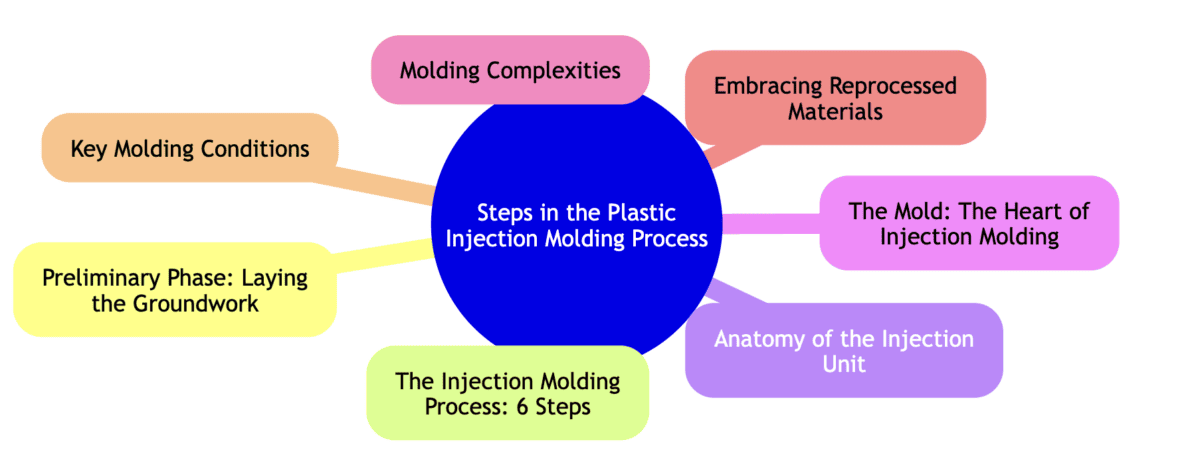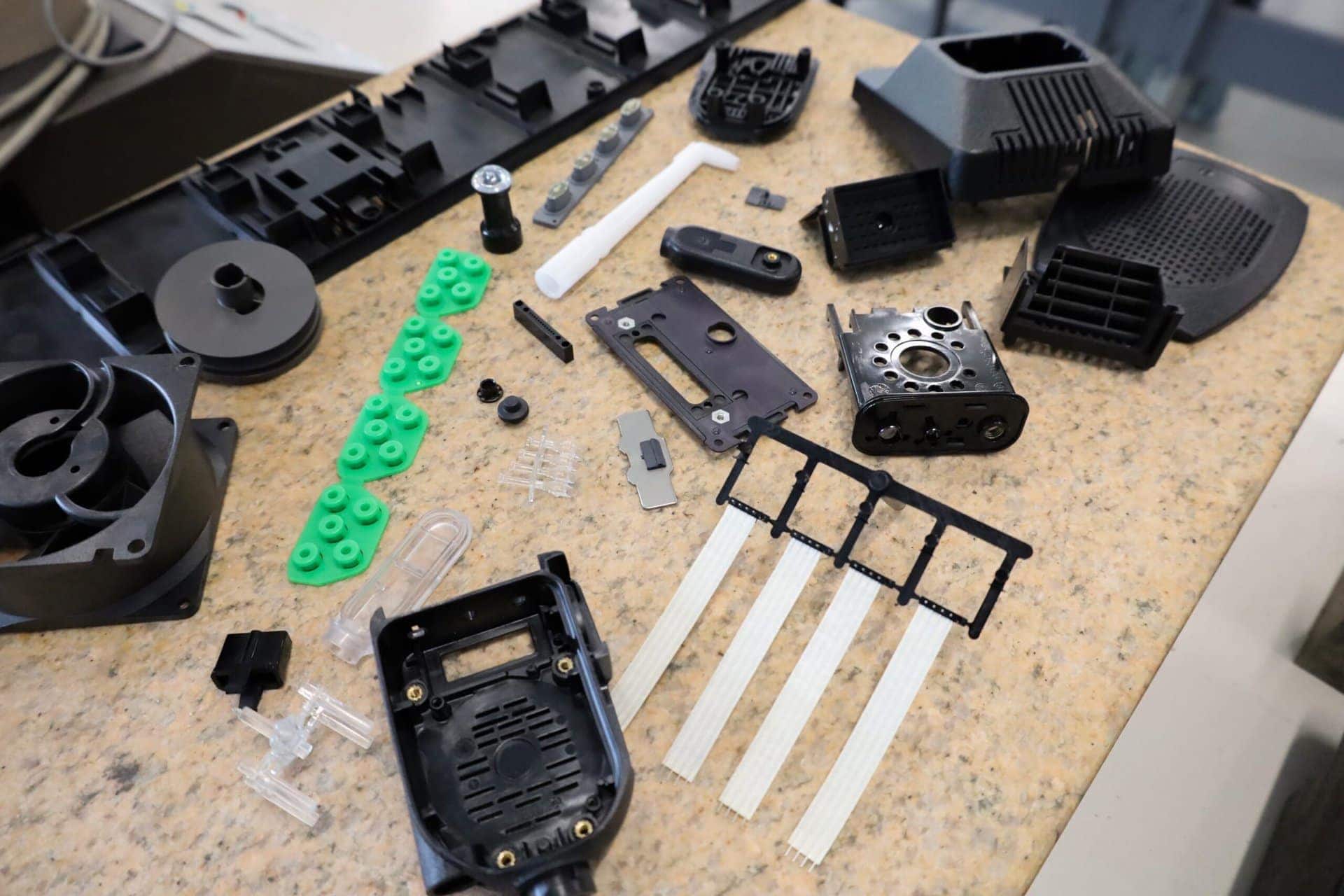Table of Contents

The industry of plastic injection molding is vast and intricately woven into the fabric of the manufacturing industry. This process stands out for its ability to produce identical parts at a swift pace – making it an invaluable asset for manufacturers.
From automobiles to consumer goods, the impact of plastic injection molding resonates across various sectors. The essence of this process lies in its 6 systematic steps. Steps tailored to guarantee that the final product aligns with the envisioned design.
Key Takeaways
|
Process Steps |
A sequence of 6 core steps: Clamping, Injection, Dwelling, Cooling, Mold Opening, and Ejection. |
|
Preliminary Phase |
Encompasses Tooling, Design, and Prototyping, often leveraging 3D Printing. |
|
Sustainability |
Utilization of reprocessed materials to reduce waste, championing eco-friendly manufacturing. |
|
Precision & Efficiency |
Attained through meticulous mold creation and process optimization for medium to high-volume production. |
|
Anatomy of the Machines |
These complex machines may be easier to understand than you’d expect. |
The 6 Steps of Injection Molding
Preliminary Phase: Laying the Groundwork
Tooling Process
The genesis of injection molding lies in the tooling process. It’s here that the molds, which are the heart of this process, are crafted to precise specifications.
This phase is pivotal as any discrepancies in the mold design can translate to defects in the final product.
Design and Prototyping
- Product Design: The journey begins on the drawing board where every aspect of the product is conceptualized.
- Prototyping: Developers bring the design to life by creating prototypes, often facilitated through 3D Printing, which provides a tangible model for evaluation and refinement.
Mold Creation
Crafting the mold is a blend of precision, engineering, and artistry. The mold goes through a spectrum of tests and refinements to ensure it’s optimized for production.
- Precision Crafting: Ensuring a high level of precision to uphold the design integrity.
- Optimizing: A meticulous process of testing and refining the mold for the production runs.
The Injection Molding Process: 6 Steps
At the heart of plastic injection molding, the process steps are where the conceptualized design morphs into a tangible product. Each step is a blend of precision engineering and material science.
1. Clamping
The stage is set with the clamping unit holding the mold securely in position.
This is where the journey of transforming plastic granules into a tangible product begins. The clamping unit is like the guardian that ensures the mold stays in place, ready to embrace the molten plastic that will soon flow into it.
Clamshell-style Pieces
The mold is often comprised of two metal plates. It is clamped securely to be ready to cradle the molten plastic.
These clamshell-style pieces are engineered to come together and part ways seamlessly. The precision in their design and operation is what lays the foundation for the accuracy of the final product.
2. Injection
The injection phase kicks off once the mold is clamped securely.
The plastic, usually starting as small granules or tiny pellets, undergoes melting to transform into a full-fledged liquid form.
This molten substance is then propelled into the mold, taking its first steps toward assuming a new identity.
Temperature Maintenance
Maintaining a constant temperature is pivotal to ensure the plastic stays molten. The rhythm of heating and injecting is a finely tuned dance that leaves no room for missteps. The temperature needs to be just right to ensure the plastic flows smoothly, filling the mold evenly. (1)
3. Dwelling
The process pauses briefly to make sure the molten plastic fills every corner and gap of the mold. This pause is essential for confirming that the process is proceeding correctly.
Pressure Application
Pressure is applied to fill the entire mold cavity, eliminating the possibility of air pockets or flaws. This step confirms that the molten plastic has completely filled all areas of the mold.
4. Cooling
The molten plastic begins its transition back to solidity – keeping the shape of the mold. As the plastic cools, it starts to solidify, taking the form of the desired product.
This is a delicate phase, a slow transformation that needs to be handled with care.
Safe Product Removal
Ensuring the cooling process unfolds in a manner that allows for safe product removal without deformities.
The cooling needs to be even and the transition from liquid to solid needs to be smooth.
This is to ensure the product is ready for the next step.
5. Mold Opening
The mold parts wa -, signaling the end of the molding process and the commencement of the ejection phase.
Readying for Ejection
The mold is carefully opened to ensure the product remains intact and is ready for ejection. This step is carried out with meticulous attention to detail to ensure the product is not damaged.
6. Ejection
The climax – the product is now ejected from the mold, ready to venture into the world.
This is the final step, the end of one journey and the beginning of another as the product moves towards its destined use.
Ejector Bar
The ejector bar is used to ensure the product is gently nudged out of the mold.
Anatomy of the Injection Unit
Delving into the core of the injection mechanism lays the foundation for understanding how plastic transforms into a myriad of products we use daily.
Melting and Injecting
- Melting Plastic: as we said earlier – before the plastic can be injected into the mold, it needs to be melted down to a liquid state. This is crucial as it dictates the flow and fill of the mold.
- Injecting Molten Plastic: The molten plastic is then injected into the mold, marking the beginning of the molding process.
Screw Rotation and Metering
- Screw Rotation: The rotating screw plays a pivotal role in both melting the plastic and ensuring a consistent flow into the mold.
- Metering: Accurate metering ensures the right amount of plastic is injected, maintaining consistency across production runs.
Machine Controls
- Injection Process Initiation: Machine controls orchestrate the injection process, ensuring precision and repeatability.
- Screw Moving Speed and Dwell Pressure: Adjusting these parameters allows for fine-tuning of the injection process, catering to different mold and material requirements.
The Mold: The Heart of Injection Molding
The mold is where raw plastic morphs into the envisioned product. Its design and condition are paramount to the quality of the final product. (1)
Definition and Functionality
- Mold Structure: Understanding the mold structure is crucial for optimizing the molding process.
- Temperature Control: Temperature control mechanisms within the mold are vital for ensuring the plastic flows and cools correctly.
Mold Detailing
- Holes for Temperature Control: Strategic placement of holes within the mold allows for temperature regulation. This is crucial for a consistent molding process.
- Mold Cavity: The mold cavity needs to be precisely crafted to ensure the final product meets design specifications.
Molding Complexities
The journey from molten plastic to a solid product is laden with complexities. Understanding these is crucial for optimizing the molding process.
Molding Components
- Sprue, Runner, and Products: The sprue, runner, and product compartments within the mold are critical for directing the flow of molten plastic.
- Importance of Multi-Cavity Molds: Multi-cavity molds enhance production efficiency by molding multiple products simultaneously.
Runner Design
- Simultaneous Cavity Filling: A well-designed runner ensures all cavities fill simultaneously, which is essential for maintaining consistency across products.
Embracing Reprocessed Materials
Reprocessed materials are a step towards sustainable injection molding, reducing waste, and promoting eco-friendly manufacturing practices.
Importance and Process
- Recycling Waste Material: Injection molding can be a more eco-friendly process by recycling and reprocessing waste materials.
- Blending with Virgin Pellets: Blending reprocessed materials with virgin pellets requires a meticulous approach to maintain product quality.
Key Molding Conditions
Molding conditions are the unseen hand that guides the molding process, ensuring each product exits the mold meeting the desired specifications.
Crucial Molding Conditions
- Temperature, Pressure, and Time: These are the trinity of molding conditions that dictate the quality and consistency of the final product.
- Material-Specific Conditions: Different materials require different molding conditions. Understanding these is crucial for optimizing the molding process.
Conclusion
Embarking on a plastic injection molding project is no small feat; it’s a sophisticated process that demands the highest levels of precision, efficiency, and repeatability.
That’s where JDI Plastics comes into play.
When you choose to collaborate with us, you’re not merely opting for a service – you’re gaining a strategic partner.
Our seasoned team of experts brings years of industry experience to the table, ensuring that even the most intricate molding challenges are navigated with ease and excellence. Give us a call today or check out our HOMEPAGE for more information and resources!
Frequently Asked Questions
- What materials are suitable for plastic injection molding?
- Various plastics including ABS, Polyethylene, and Polystyrene are commonly used in injection molding.
- How does the tooling process impact the overall injection molding process?
- The tooling process is crucial as it involves creating the mold which is the foundation of the injection molding process.
- What role does temperature play in plastic injection molding?
- Temperature control is pivotal during the injection and cooling stages to ensure the plastic flows and solidifies correctly.
- How do I get started with plastic injection molding?
- Engaging with reputable fabricators and having a well-thought-out design are the initial steps towards starting with plastic injection molding.
- Why is plastic injection molding popular for mass production?
- Due to its ability to produce large volumes of identical parts efficiently and cost-effectively, plastic injection molding is a preferred choice for mass production.
References:
- Britannica, Injection Molding, https://www.britannica.com/science/plastic/Injection-molding

JDI Plastics is a custom injection molding company that specializes in providing products at the highest quality standards, while simplifying our customers’ supply chains through production management and value-added services.

